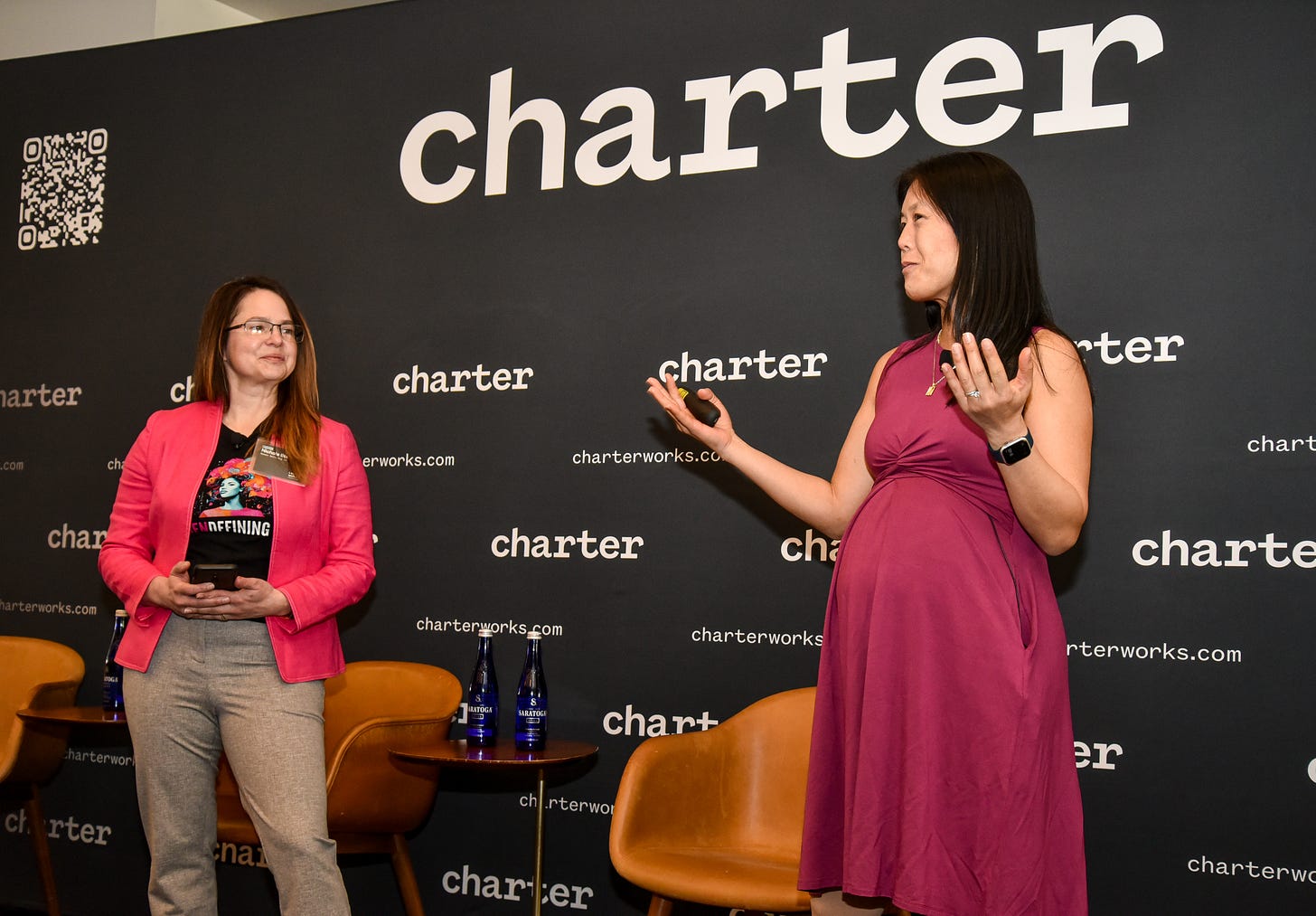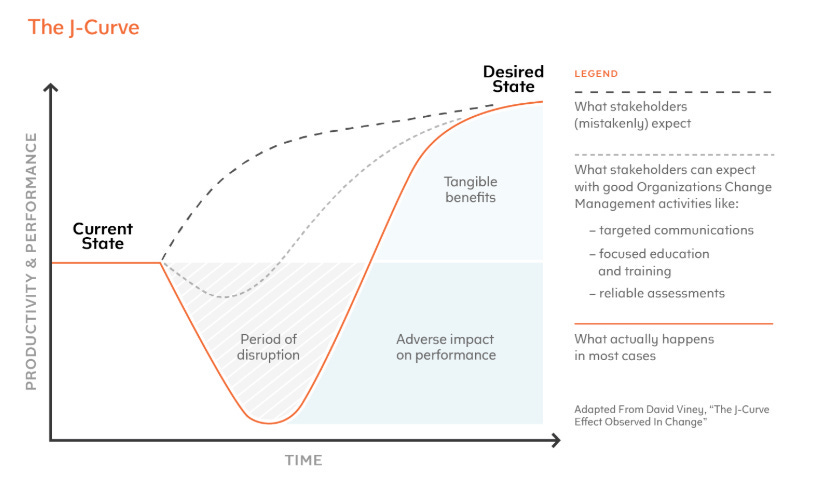Team-Centered AI: Here's What Works
Part 2: practical strategies for creating learning environments that drive results
Part 1 covered the emotional barriers to AI adoption in enterprises. Today, let’s get into what actually works: the strategies that successful organizations are using to overcome fear and create meaningful AI integration.
Helen Kupp, who led a session with our leadership forum last week, put it perfectly: "The best leaders that I've talked to, the companies that are thinking about it differently, are not thinking about replacement. They're thinking about how this actually transforms other roles that couldn't do these things before."
Helen Kupp, Women Defining AI co-founder Nichole Sterling at Charter’s AI Summit
Let's dive into the approaches that are working.
Three Foundational Approaches
First, invest dedicated time for learning and experimentation. The J-curve is real: you'll get worse before you get better when performance comes from fundamental redesign. Leaders need to account for this temporary productivity dip.
Successful organizations create dedicated space for this learning:
Workshops and hackathons: Teams have dedicated an afternoon during their offsite to hands-on experimentation with AI tools, together. Other examples include Udemy’s U-Days.
Weekly learning sessions: Helen shared how one CPO "would block off an hour on Fridays over lunch, just to get her team logging and trying things together."
Daily micro-learning: "I try to keep the learning at 10 to 15 minutes a day of like, one concept and one idea, and then do that for about a month," Helen explained. Zapier employees share what they're trying in internally public Slack channels.
The productivity paradox: becoming more productive requires investing in seemingly "unproductive" learning time.
Second, balance freedom to explore with governance guardrails. Helen emphasized this balance: "You want to decentralize the experimentation to people and teams and their departments. You want to centralize governance and things like what are the enterprise-grade tools that we want to unlock for everybody."
Debbie Lovich at BCG also found that team-level experimentation boosts adoption. Her research shows that active engagement by managers working with their teams accelerates AI adoption by 4X.
Third, win by eliminating soul-crushing toil. Barb Cadigan, Chief People Officer at Affirm, shared that they formed a cross-functional "tiger team" of AI enthusiasts from various functions. Their approach worked because they started with solving real problems and focused on toil.
Their Legal and Compliance team went at this early given their sizable manual load. The team targeted those pain points, built solutions, and started counting hours saved. Success stories created momentum that spread organically.
What’s next? Once you've let a thousand flowers bloom, you can follow examples like J&J: trim back to the 10-20% that drives 80% of the value and drive those solutions deeply into the right teams.
Measuring Progress
Corina Kolbe, VP of Talent Success at Zillow, raised a critical point about defining what "good" looks like with AI skills: "With any other thing, we can set learning objectives: you're proficient if you do this, this, and this. But here, it's constantly changing."
Helen's response was pragmatic: focus first on frequency of usage. "The more you use it, the more you understand the failure modes and even just simple things like how to prompt better."
We also discussed a three-stage evolution that mirrors the usage maturity curve that Helen and I saw in practice at Slack in its growth stage:
Basic Usage: Determine how extensively AI tools are integrated into everyday workflows.
What percentage of employees use AI tools in any form on a daily basis?
Example: Zapier moved from 65% initial usage to 89% daily AI tool adoption across their workforce.
Customized and Collaborative Usage: Understand the depth of personalized AI engagement.
What percentage of employees regularly use customized GPTs or personalized AI agents daily?
What percentage of employees have actively created their own AI assistant or custom GPT?
Scaled and Integrated Usage: Measure the maturity and scale of AI integration into organizational processes.
What percentage of core workflows and tasks across the organization are routinely supported or automated by integrated AI agents and automation systems?
Across the organization, we also need to look at one more factor:
Collaborative Learning: Measure whether you're promoting knowledge sharing. How effectively are best practices, prompts, and custom GPT configurations being shared across teams?
This progression reveals whether you're heading in the right direction and identifies your expert users—champions who can help others level up.
Practical Next Steps
Ready to accelerate your organization's AI adoption? Start here:
Identify your AI champions: They're already in your organization, experimenting on their own. Find them, support them, and amplify their work.
Dedicate time for learning: Block specific times for exploration—whether it's weekly sessions, hackathons, or time in team offsites.
Start with real pain points: Ask teams to identify their "worst workflows" and explore how AI might help.
Create sharing mechanisms: Build channels for teams to share prompts, use cases, and lessons learned.
Measure your progress: Leverage the maturity curve to see where you’re gaining traction versus who needs support.
The gap between startup agility and enterprise adoption isn't about resources or technology—it's about emotion, culture, and leadership approach. The installed base of code and customers will make the impact harder to see – but also creates advantages of scale.
The organizations succeeding with AI aren't just implementing new tools; they're creating environments where people feel empowered rather than threatened by technological change.
Where are you on the maturity curve? What team-centered AI adoption strategies are working in your organization — or what’s holding you back?
ICYMI
Check out Helen's AI for Business Leaders course. Brand-new, based on courses I've taken with her and her work with thousands of people and dozens of leaders.
Klarna: We need more humans
Related to the topcis above, AI poster child Klarna is pulling back, a bit, from it’s AI aspirations.
“As cost unfortunately seems to have been a too predominant evaluation factor when organizing this, what you end up having is lower quality. Really investing in the quality of the human support is the way of the future for us.”
Klarna was the early poster child for genAI-fueled cost cutting. They took a reasonable approach: stopped hiring, told employees to adapt new tools to ensure career longevity, and used attrition to lower costs (vs layoffs).
Siemiatkowski still expects that to happen: with an attrition rate of 20%, he expects to see full time employees drop for 3,000 to 2,500. Side note: 20% is really high in tech these days!
Where do the new customer service agents come from? Remote contract workers who are "candidates such as students or rural populations."
The Workplace Psychological Contract is Broken
"Once you replace trust with rules, people’s attitudes to their work change."
Want to see "quiet quitting" in action? Forcing people to follow policy drives down engagement through a loss of trust. This fundamental insight explains why RTO mandates often backfire.
Professors Anne-Laure Fayard and John Weeks recent column in HBR digs into one of my favorite topics: why one-size-fits-all workplace policies fail.
“The best person to answer the what matters question is the line manager, who is familiar with the work context and knows employees better than the execs or HR”
Global teams face a particularly absurd challenge: commuting to empty offices just to video call colleagues across time zones
The disconnect is huge: Executives pushing universal policies live different lives with different support systems than their employees
What they’re describing is human-centered leadership. Listening to your teams, understanding their needs in order to perform. Too often, that’s seen as "soft." It’s not: human-centered leadership means being both demanding AND dependable. As Sophie Wade put it, "being empathetic doesn't mean being nice." It's hard work.
The authors’ "ethics of care" approach -- emphasizing empathy and individual needs over rigid policies and rules – works:
Deep listening beyond surface empathy to understand how teams actually function
Customized approaches that acknowledge different team and individual circumstances
Breaking the false binary: connection happens virtually, and remote teams still need in-person gatherings
Gallup: Remote Workers more Engaged, Less Thriving
Gallup’s latest State of Workplace survey shows that remote workers are:
35% more likely to be highly engaged (31% vs 23%)
14% less likely to be thriving (36% vs 42%)
Much higher engagement is good; higher levels of stress, sadness and loneliness are not. Three thoughts based on the research I've seen:
Causation or correlation? Remote roles are more likely in industries like tech and roles like engineering. Those same roles are also under a lot more pressure: AI spend creating massive pressure to do more -- partly because of tools but also because spend on AI crowding out spend on humans in tech.
Remote workers are the tail on the whip of the drive for efficiency. Demands that people “do more with less” results in a feeling that every moment has to be productive, making every meeting efficient and eliminating time that could also be used for connection. Hybrid workers get some "less efficient" days in office.
Fully remote isn't what most people want. Future Forum research showed only 15% globally want to be fully remote (<1X/month with their teams). It's likely given the job market that these are employees who do want to be remote, but they might be missing other elements -- like team gatherings...
What can you do to help?
Ensure regular team gatherings. Find the funds. Create the space on your calendars, and in our workplaces.
Build virtual connections. Icebreakers, virtual watercoolers, personal user manuals, and keep those weekly 1:1s with team members.
Stop trying to do more with less. Get real about prioritization and clear goals.
p.s. it’s not like I haven’t said remote doesn’t work for many people…
Still here? Thanks for reading! Feedback always welcome.



